DEATH GUARD And now time for some advice for those of you who like things on the foul side, revel in all things rotting and tend not to mind the odd stench or two. Take heed as Ryan Powell reveals the lessons he has learned in fielding Plogue Marines, Nurglings and the uncleanest of hosts. Whether on foot, in vehicle, or summoned, the followers of Nurgle have every right to be feared on the tabletop. Their resilience and skill is second to none. As silent and effective as their battle cry, the Plague Mannes of Nurgle seek to spread disease and pestilence to the universe, all in the name of their dark god. It is well known that Nurgle armies are one of ihe hardest and most resilient armies available for the Warhammer 40,000 universe. With almost every figure offering a high Toughness and good Armour save, Nurgle is a real force lo be reckoned with on the battlefield With this in mind, your choice is set, but where to start? Codex: Chaos Space Marines offers a wealth of choices for you to assemble your army. Hopefully, with a little insight from long-term Nurgle player Ryan Powell, this article will point you in the right direction, and bring death and disease to the followers of the False Emperor at the same time.
Plague Marines are quite possibly the best tactical troops in the game. At 19 points per model you receive a Fearless Space Marine, with Toughness 5, True Grit, armed with a bolter and close combat weapon. These disease-ridden troops function equally well in assault as defense and are the core oi any Nurgle army. This combination of battlefield effectiveness and resilience is the key to your army's success. The only real downside to Plague Marines is their relatively high points cost, so you can count on being outnumbered. Fortunately, Nurgle troops pride themselves on being able to take a large amount of abuse. The sacred number of Nurgle is seven and units organized into this sacred number (or multiples of) are considered favoured by their dark god. and receive bonuses because of this. For Plague Marine squads this means a free Aspiring Champion upgrade for one squad member. One of the problems that Nurgle will face is that, while they can take an awful lot of beating, they cannot dish it out as quickly as other close-combat armies can. I have found the simple addition of a Champion with a power fist (or power weapon) typically helps to offset this by providing the needed killing power for your unit. While the idea of your plague-ridden troops waltzing across the battlefield, bolter shells bouncing off their distended guts, may sound appealing (if not a little disgusting), they can have a great deal of trouble in achieving this, if left unsupported. Your restricted choices offer few options to get around this little problem, the easiest being the addition of a few transports. By fielding a pure Death Guard army, you are limited to two Plague Marine units in Rhinos as Troops, with any additional mounted units becoming Fast Attack. Not only does the addition of a few Rhinos allow you to get into grips with the enemy earlier, they also provide great cover from low AP weapons, which will spell almost certain death for your already expensive models. These mounted Plague Marine units are not your only option for speed and mobility, as Plague Marine Havocs can also take Rhinos. Since any model bearing the Mark of Nurgle cannot use a heavy weapon, your choice of weapons becomes limited to flamers, plasma guns, and melta guns. I have found the best way to field these units is in specialized roles, depending on the rest of your army. A Havoc squad armed with four melta guns and a Rhino can use their added mobility to get within melta gun range quickly or alternatively a squad with four plasma guns can provide great supporting fire, especially against well armoured units such as Space Marines. 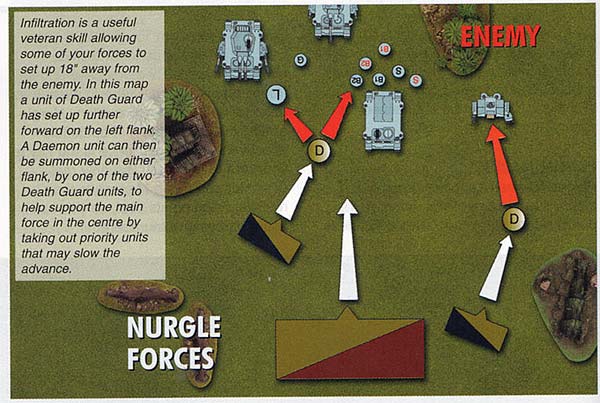
Another option for added battlefield advantage is the inclusion of a few infiltrating units. Infiltration is a veteran skill that is available to any Plague Marine unit. I have found that not only does the ability to set up as close as 18" from your enemy greatly assist you, but the mere fact that you get to set up after your opponent with these units can assist you to focus your attack. Although the skill will not be useful in every scenario, my advice is to strongly consider this as a squad upgrade, as it has helped me more times than not. Without a doubt, I have found the largest advantage that any Chaos army has is the use of Daemons. These units provide much needed support for your expensive Plague Marine units, and are very specialized at what they do. 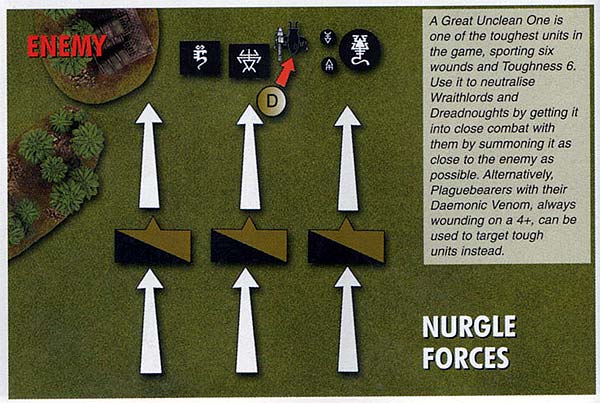
First on the list of Daemons available to a Death Guard army is the mighty Great Unclean One. Rightly feared, the Greater Daemon of Nurgle is a terrifying behemoth on the battlefield. Sporting a massive six wounds, he is one of the hardest units in the game to destroy. Greater Daemons can be useful to your army in a variety of ways. First and foremost, they are terrifying in hand-to-hand combat. As they are monstrous creatures they ignore Armour saves and have a high Strength. This should be more than adequate to be able to tear down the most powerful of characters and vehicles. With his Toughness of 6, he cannot suffer Instant Death by even the most powerful weapon in the game either. This ensures that the Daemon will hang around long enough to cause trouble for your opponent. The Great Unclean One can also provide powerful support against units that normal Plague Marines cannot possibly take care of. My advice is to use him against such units as the Eldar Wraithlord and Dreadnoughts. Both of these units can decimate an entire unit of Plague Marines, however, they are easily taken down by the Greater Daemon. At the beginning of the game you are required to select a model to act as your daemonhost. I would suggest using a simple Aspiring Champion. The daemonhost fights with the strength of the Greater Daemon even before possession occurs, so that will give your lowly champion a very useful high Strength, combined with whatever weaponry he is wielding.
There are several points to cover about summoning before we continue to the best use of them. First off, never forget that if your Plaguebearer units are organised into the sacred number of Nurgle you receive a +1 to your summoning roll. This means that on Turn 2 you will get them on a 3+. which is a very good chance. If you make the roll, you MUST summon them if there is an icon available. What this means is that if you have, say, two Daemon units in reserve and you make both Reserve rolls, you must bnng them on. In my games I have found that you can only wait so long to launch your attack; lest your Plaguebearers end up summoned too far away to be effective. !n addition, you must place the ordnance template so it is touching a single model on your side bearing a Chaos icon. I personally try to have at least one icon in a useful place on the battlefield; otherwise I may lose the opportunity to maximise the added strength of numbers the Daemons bring. Plaguebearers can provide much needed assistance when things go wrong, due to the fact that they are held in reserve. This means that you can bring them in wherever you think they will help you the most. Where your opponent thinks he is facing one unit, this can quickly become three units, or when the dice just don't go your way, they can add strength to let you break a unit, or capture a table quarter. Another tactic that I have used, when all else fails and I am having trouble getting to grips with the enemy, is to rush forward as far as I can, place the template, and hope it scatters! I cannot count the number of times the Daemons have scattered towards an enemy unit that otherwise would have been able to shoot in the next turn had my horde of pestilent minions not tied them up (then again, it's probably the same amount of times they have scattered right in front of the heavy bolter squad....). 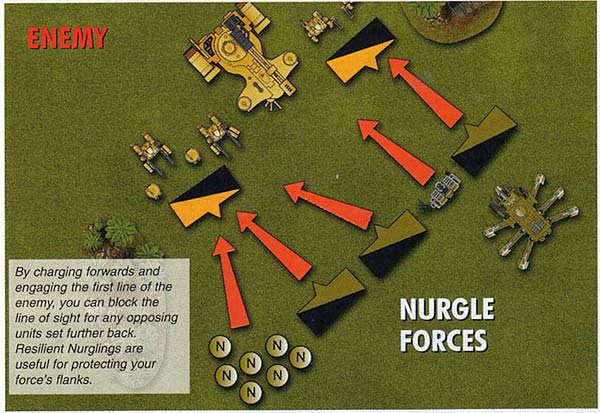
The final Daemon choice available to you is Nurglings. Sadly, it seems that these diminutive creatures are often underestimated and ignored by most players. Although they cannot hold table quarters or an objective, they provide you with a large swarm ot creatures. Additionally, an entire unit of Nurglings is worth few Victory Points. This means that you can quite literally throw the Nurglings at the enemy. Your opponent has the choice of either firing at your more resilient, expensive troops, or the Nurglings. More often than not. the Nurglings will be ignored which means your opponent has left the door wide open for you to get into assault. Once tied up in close combat, Nurglings are hard to get rid of as they have a high number of wounds and are unbreakable. If all else fails, I have used Nurglings to lie up more expensive and powerful hand-to-hand units such as Incubi, Honor Guard, etc. I have lumped both of these units together due to their similar traits: high killing power, high points cost, and limited usefulness. Chosen squads considerably more expensive than your normal Plague Marine unit. They have a few options that your normal units cannot take advantage of, with the most notable being Terminator armour. I believe that Plague Terminators are quite possibly the most powerful Terminators available. The added protection of Terminator armour, combined with the already high Toughness of Plague Marines is a nasty combination. These do not come cheap; as even your basic Plague Terminator is going to cost you 36 points per model, but their high availability of special and unique weapons means that you can tailor the unit to whatever task you see lit. Possessed have a few options that are unique to them, however, I have found the basic Possessed Plague Marine without any special abilities to be the most cost effective. They are almost as good as a Terminator, and certainly more powerful than your typical Space Marine. This is due to their high Strength, Toughness, and the addition of a 5+ Invulnerable save. 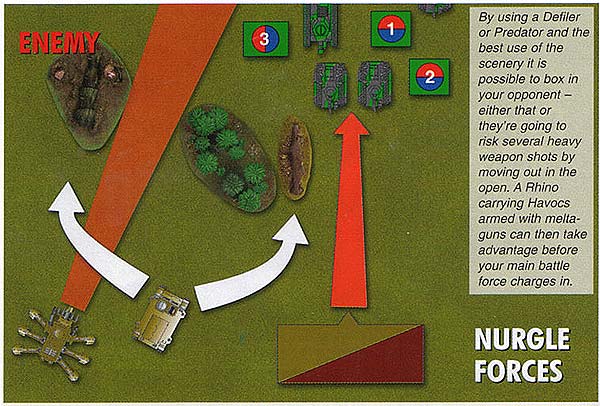
All this time spent poring over the codex and planning your army is the start of your tactics, as what you assemble and field will be the basis for any attack you may launch. However, this is only the first step. The real test of a general is on the battlefield, and your Death Guard army is no exception. In my opinion, the real key to a Death Guard army is its ability to use a variety of unique and specialized units to support one another. I have found a certain finesse is required to really maximise their strengths. 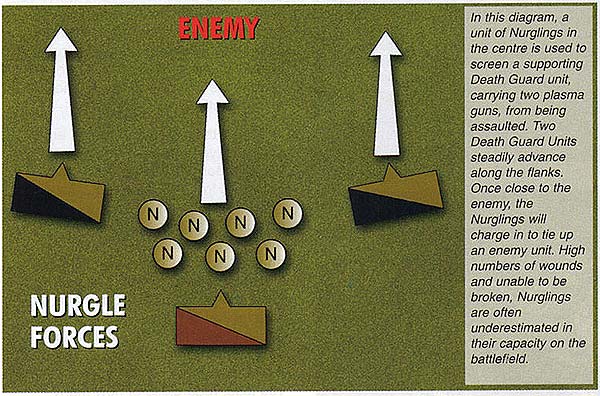
To fully utilize your army you must learn to analyse and dissect your enemy's forces. The Death Guard did not live to be 10,000 years old by foolishly waging war against that which they cannot defeat. Leave that for the World Eaters. Your heavy support units will offer invaluable support in this instance. I suggest having their primary objectives be things that can quickly dispose of your Plague Marines. Talos, Wraithlords, Leman Russ, etc. can all halt your assault dead in its tracks for slime trail as it may be) if not dealt with properly. While some armies strive to take out enemy transports and other assault units, yours does not need to worry so much. I have found that the best place to be is in hand-to-hand combat with your enemy as this allows you the benefit of using the Plague Marines' high Toughness and fearlessness where it is most effective. I suggest that when assaulting, engage units that you can kill outright or ones that can potentially cause you lots of problems for other squads if allowed to charge you. If they are set up in a deep line of squad after squad, I often assault the front unit so that it will block the enemy's line of sight. Using your Daemons to add numbers to your assault and crush one squad at a time is a tactic that can often be the direct cause of victory, or defeat. I cannot stress enough the concept of sticking to the objective - if you fail your mission you lose, regardless of how many loyalist scum you send to their makers (even though it makes for loads ot fun). 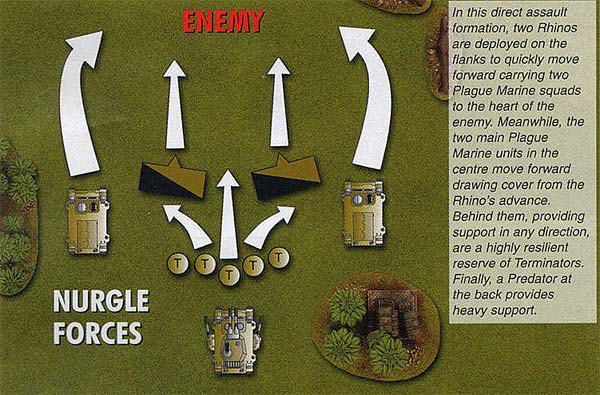
Thus far, all my talk has centred on the offensive, but what about the defensive? Some may say that Chaos armies are best suited as the attackers. However, the Death Guard can just as easily be a solid defensive army. Remember that the key advantage of the entire Death Guard army is their high resistance to punishment. When you must be defensive. I suggest keeping your head, planning your counter-attack, and taking appropriate actions. Target selection is just as important when defending as when launching an attack. An example is that a swarm of Tyranid Hormagaunts will have a huge problem taking out Toughness 5 Plague Marines in hand-to-hand combat due to the combination of their low Strength and your high Toughness. Also, the addition of Nurgle's Rot (see side) makes them even easier to deal with. On the other hand, I have found Carnifexes and Hive Tyrants to be some of the most feared units in the game. I suggest dealing with them in the conventional way; with your heavy support. I always say that it's better to assault, than to be assaulted, so don't bauik at the notion of charging if the need arises. Experience has shown me that seven Plague Marines (remember your sacred numbers) can take on a swarm if done properly. Orks are no exception to this rule, deal with them in much the same manner. Let the choppas come, they need to roll very well to cause any significant damage, an advantage that I have found few armies to possess against these hordes.
This consists of a detailed build-up of my army, news updates, fiction, images, and discussion lorums. With over 200 registered Death Guard commanders, it's a great place to get ideas for not only playing the Death Guard, but also for painting, converting, and indeed all aspects of the Games Workshop hobby. The second resource that I will strongly suggest is the Bolter and Chainsword website: With forums for all the major Space Marine chapters, this too is a great forum for the Death Guard commander. The site offers a dedicated Chaos section, as well as more expansive forums for modelling, discussion, and tactics. As the site administrator of Deathguard.org and a moderator at the Bolter and Chainsword. I am easily contactable if anybody has the desire to do so, just look for the user kenshin138 and drop me a line. Although your choice of units may be limited, faith in Nurgle can carry you a long way. What they lack in tactical finesse is made up with rock hard resilience. With your high Toughness you can wade into situations that a normal Space Marine would baulk at. Combined with a host of daemonic support and solid tactics, the Death Guard are rightly feared. Use this to spread plague and disease throughout the galaxy. In the end, all is committed to death and decay in the name of Father Nurgle. |
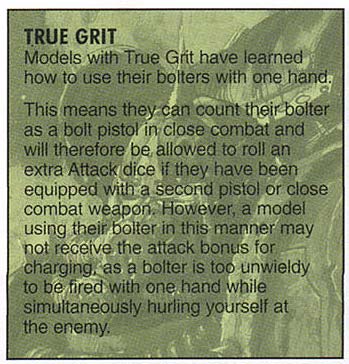 Ryan:
In my opinion playing any Chaos cult force (ie, dedicated to one single
god) limits your choices quite a bit. Since army selection is one of
the easiest ways I have found to ensure a tun, yet competitive, outing
on the battlefield, let's begin with that. By choosing the Death Guard,
you lose many of the more flashy aspects available to a Chaos army,
including Raptors, Obliterators, heavy weapons, Furies, and a host of
other items. What you are left with is what I have found to be some
of the best units that you can field. Plague Marines and Daemons will
be the meat of your army, supported by Terminators and Heavy Support.
While all of this sounds fairly straightforward, it is much harder to
pull together on the tabletop. You should plan on building a concentrated,
goal-orientated army. Where an army such as the Space Marines offers
a great tactical variance. a Death Guard army is more focused, and this
focus must be maintained for victory and glory for Nurgle.
Ryan:
In my opinion playing any Chaos cult force (ie, dedicated to one single
god) limits your choices quite a bit. Since army selection is one of
the easiest ways I have found to ensure a tun, yet competitive, outing
on the battlefield, let's begin with that. By choosing the Death Guard,
you lose many of the more flashy aspects available to a Chaos army,
including Raptors, Obliterators, heavy weapons, Furies, and a host of
other items. What you are left with is what I have found to be some
of the best units that you can field. Plague Marines and Daemons will
be the meat of your army, supported by Terminators and Heavy Support.
While all of this sounds fairly straightforward, it is much harder to
pull together on the tabletop. You should plan on building a concentrated,
goal-orientated army. Where an army such as the Space Marines offers
a great tactical variance. a Death Guard army is more focused, and this
focus must be maintained for victory and glory for Nurgle.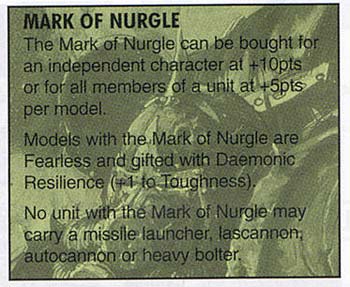 Plaguebearers,
your second choice of Daemons, are an excellent supporting unit, as
their daemonic venom allows them to wound any creature on a 4+. They
are particularly useful at assaulting Wraithlords. C'Tan, and large
Tyranid creatures. At 16 points each, they are also moderately less
expensive than Plague Marines, and offer the same profile. Many people
shy away from Daemons because of the low Armour save or the summoning
rules. The summoning rules should be seen as an advantage rather than
a flaw. Since they are always summoned I have found that they can offer
support in ways that no other army can offer.
Plaguebearers,
your second choice of Daemons, are an excellent supporting unit, as
their daemonic venom allows them to wound any creature on a 4+. They
are particularly useful at assaulting Wraithlords. C'Tan, and large
Tyranid creatures. At 16 points each, they are also moderately less
expensive than Plague Marines, and offer the same profile. Many people
shy away from Daemons because of the low Armour save or the summoning
rules. The summoning rules should be seen as an advantage rather than
a flaw. Since they are always summoned I have found that they can offer
support in ways that no other army can offer.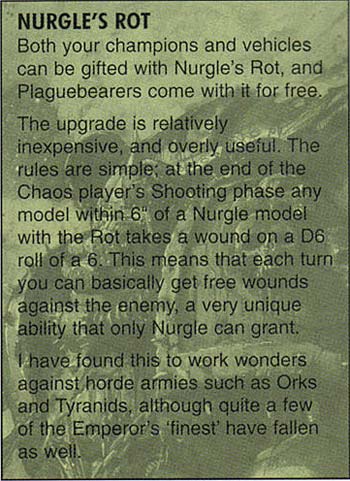 The
first item I will cover, is that of deployment. As the cornerstone to
any tactical plan, where your units are, where they can get to, what
they can see, are all crucial to your success. One needs to keep in
mind what the opponent is using as well, including weapons, speed, and
what the apparent play of them may be. Generally, I suggest setting
up your army with the belief that you will not get the first turn as
the best plan. As all too often happens, assault armies rely heavily
on the 'first turn advantage' too much. Set up your transports behind
cover or hull down to provide some extra help when the enemy line starts
dropping shells on you. Also consider where you can get to. A Rhino
that is hidden behind a forest but has no other cover within 12"
is going to have almost as hard a time of it as a Rhino out in plain
view. I suggest trying to stagger your assault to keep your forces alive
until they get to the enemy. Where possible, I would also recommend
sending a strong push up one flank. Since you will be outnumbered already,
this can help you concentrate what few numbers you have against your
opponent.
The
first item I will cover, is that of deployment. As the cornerstone to
any tactical plan, where your units are, where they can get to, what
they can see, are all crucial to your success. One needs to keep in
mind what the opponent is using as well, including weapons, speed, and
what the apparent play of them may be. Generally, I suggest setting
up your army with the belief that you will not get the first turn as
the best plan. As all too often happens, assault armies rely heavily
on the 'first turn advantage' too much. Set up your transports behind
cover or hull down to provide some extra help when the enemy line starts
dropping shells on you. Also consider where you can get to. A Rhino
that is hidden behind a forest but has no other cover within 12"
is going to have almost as hard a time of it as a Rhino out in plain
view. I suggest trying to stagger your assault to keep your forces alive
until they get to the enemy. Where possible, I would also recommend
sending a strong push up one flank. Since you will be outnumbered already,
this can help you concentrate what few numbers you have against your
opponent.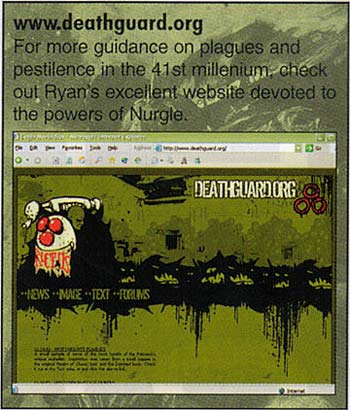 Like
any army, there are many ways to construct and play the Death Guard.
Instead of simply following my concepts, why not discuss and entertain
other options? There are several great resources on the Internet that
any novice, or even experienced, Death Guard player can take advantage
of. The first and foremost is (humble), my own website:
Like
any army, there are many ways to construct and play the Death Guard.
Instead of simply following my concepts, why not discuss and entertain
other options? There are several great resources on the Internet that
any novice, or even experienced, Death Guard player can take advantage
of. The first and foremost is (humble), my own website: